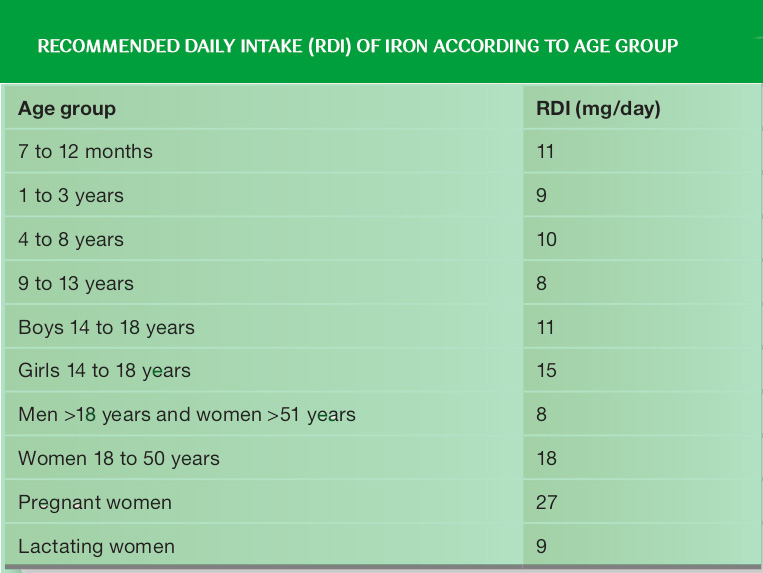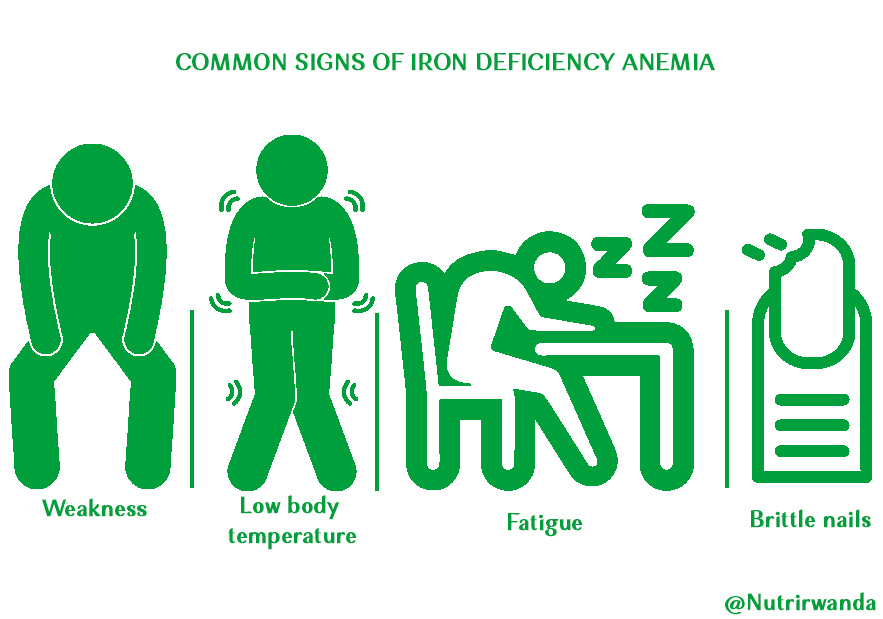Iron deficiency is a highly prevalent form of under-nutrition, affecting around one-fourth of the world’s women and children, and is one of the most common causes of anemia. According to World Health Organization “Among the 30 African countries for which survey data are available (2003–2015), the median prevalence of anemia in pregnant women is 47.3%. whereas in Rwanda it stands at 23.4% among women aged 15-49.
Nutritional anemia is a condition in which the hemoglobin content of blood is lower than
normal as a result of a deficiency of one or more essential nutrients.
Iron deficiency anemia (IDA) is the most common nutritional cause of anemia and occurs when there is an inadequate amount of red blood cells caused by lack of iron.
World Health Organization Grading of anemia
• Children under 5 years of age and pregnant women living at sea level as anemic if their hemoglobin concentration is <11 g/dL
• Non-pregnant women as anemic if Hb <12 g/dL,
• Men as anemic if Hb <13 g/dL.
• Mild-moderate anemia is Hb 7–10.9 g/dL,
• Severe anemia is Hb <7 g/dL
Anemia is actually a sign of a disease process rather than a disease itself as Deficiency of Iron, folate and vitamin B12.
FUNCTION OF IRON IN THE BODY
Up to 80% of absorbed iron is used for the synthesis of hemoglobin (a protein in red blood cells), which is responsible for the transport of oxygen in the body. As a component of hemoglobin, iron is used to store oxygen in the muscles. Iron also plays an important role in the supply of energy within cells and is involved in the production of hormones and other messenger molecules
SIGNS AND SYMPTOMS OF IRON DEFICIENCY ANEMIA
Iron-deficiency anemia often develops slowly, and symptoms may be mild at first. As the condition gets worse, you may notice symptoms including:
• Fatigue (very common)
• Weakness (very common)
• Dizziness
• Headaches
• Low body temperature
• Pale or yellow “sallow” skin
• Rapid or irregular heartbeat
• Shortness of breath or chest pain, especially with physical activity
• Brittle nails
• Pica (unusual cravings for ice, very cold drinks or non-food items like dirt or paper)
THE MOST COMMON CAUSE OF IRON DEFICIENCY ANEMIA
- A given diet may be low in iron or may contain adequate amounts of iron which are of low bio-availability
- Common infections, especially those which are chronic and recurrent such as malaria, and some parasitic infections, e.g. hookworm, amoebas, This blood loss contributes to iron deficiency.
- Low bio-availability of iron in cereal- and tuber-based diets as they contain high amounts of
- polyphenols (tannins) and phytates that inhibit iron absorption.
CONSEQUENCES OF IRON DEFICIENCY ANEMIA
Iron deficiency and iron deficiency anemia have a significant impact on human welfare both at the level of the individual and for the economic development of a country.
- Deficiency can slow growth, hinder physical and mental development, and reduce the ability of the body to maintain itself.
- It is associated with impaired immune response, lowered resistance to infection and increased morbidity and mortality rates
- It hinders the cognitive performance, behavior, and physical growth of infants, preschool and school-aged children.
- Iron deficiency anemia during pregnancy increases maternal hemorrhages and maternal morbidity and mortality rates.
- Reduces the physical capacity to do work
INCREASING THE IRON BIO-AVAILABILITY TIPS
Practical interventions to reduce dietary inhibitors and increase iron absorption facilitators
include:
- Ensuring dietary intakes of oils and fats, vita min A, and of Vitamin C are adequate for enhancing absorption of micro-nutrients especially Iron.
- Fermentation and germination for the enzymatic hydrolysis of phytates present in cereal bran, cereal grains, high-extraction flour, legumes, nuts, and seeds
- Avoiding drinking tea or coffee within 2 hours of eating meals
- promoting the availability of, and access to, iron-rich foods. Examples include meat and organs from cattle, fowl, fish, and poultry; and non-animal foods such as legumes and green leafy vegetables.
- Consume milk, cheese, and other dairy products as a between-meal snack, rather than at mealtime due to calcium which may Inhibits of iron absorption.
- Include in the meal fruit juices such as orange juice, or another source of Vitamin C such as tubers, cabbage, carrots, or cauliflower
IRON SOURCES
There are two types of dietary iron:
- Haem iron: Found in animal sources such as red meat and, to a lesser extent, in poultry and fish
- Nonhaem iron: Found in eggs and plant-based sources such as nuts, cereals, bread, beans and vegetables.
RECOMMENDED DAILY INTAKE (RDI) OF IRON ACCORDING TO AGE GROUP

FOODS THAT ARE RICH SOURCES OF IRON
Animal iron source foods
- Oysters
- Liver
- Lean red meat (especially beef)
- Poultry, dark red meat
- Lamb, pork, shellfish
- Eggs (especially egg yolks)
- Tuna, salmon
Plant based iron source
- Whole grains: wheat, millet, oats, brown rice, lentils
- Iron fortified cereals
- Legumes: Black beans, soybeans, dried Bean, peas, kidney beans
- Seeds: almonds, pumpkin seeds, sesame seeds, sunflower seeds, Groundnuts
- Dried fruits: prunes, raisins, apricots, apples
- Green leafy Vegetables: Dodo, broccoli, spinach, green beans, beet greens, kale, collards,cassava leaves (Isombe), lettuce, Asparagus, dandelion greens, broccoli, cabbage, Potatoes, Mushroom, Beets
REFERENCES
- Brian Thompson ( 2014), Food-based approaches for combating iron deficiency, Rome, Italy
- LISA CLARKE Et al, (2014), iron deficiency anemia- Causes, symptoms and treatment, VOLUME 15, NUMBER 11,
- SPRING. 2017. Understanding Anemia: Guidance for Conducting a Landscape Analysis. Second Edition. Arlington,VA: Strengthening Partnerships, Results, and Innovations in Nutrition Globally (SPRING) project
- USAID’s Integrated Anemia Prevention and Control Toolkit on the Knowledge for Health website (https://www.k4health.org/toolkits/anemia-prevention)
- WHO (2018), Iron Deficiency Anaemia, Assessment, Prevention, and Control- A guide for programme managers,
- WHO Regional office for Africa (2017), Nutrition in the WHO regional Africa, Brazzaville
